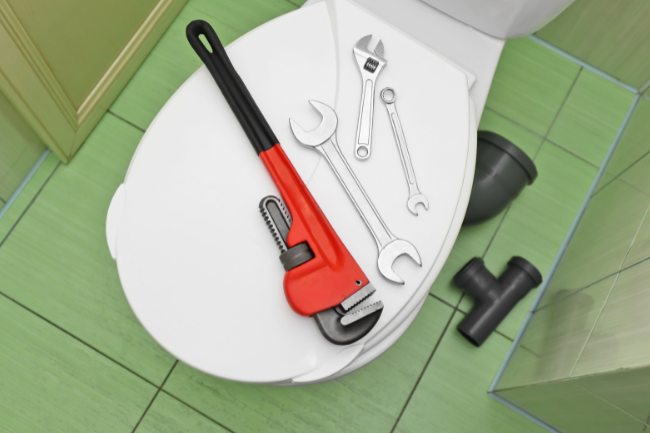How to Locate Your Main Shut Off Valve & Turn Your Water Off
Posted by William Heinselman on

Broken pipes or major pipe issues can cost you thousands of dollars in damages.
The good news is that you can avoid major water leaks in your house. Some of the most common pipe problems, like leaking supply lines, frozen pipes, ruptured water hoses, and dripping heaters, can be solved with a simple fix – turning off your main water shut-off valve.
Let's review some of the easiest ways to locate your main shut-off valve and the steps you need to follow to turn it off to save yourself from a water damage disaster.
How You Can Prevent Emergency Plumbing Repair By Turning Off Your Water

All homes and places of business are required to have main water shut-off valves during initial construction. For most water pipe repairs or emergencies, the correct valve is located inside the property. However, some are located outside, underground in a pit, or near the property line.
Property owners should know where their shut-off valve is located and how to shut it off when they first notice signs of a broken pipe – before it becomes an even bigger problem.
Knowing the process for shutting off your water can be a valuable tool in preventing emergency plumbing repairs. Many homeowners or business owners may not realize that a simple task like turning off their water supply can potentially save them from costly and stressful repairs. In the event of a burst pipe or major leak, being able to quickly shut off the water can minimize the damage and give you time to call a professional plumber.
Additionally, if you are going on vacation or leaving your home for an extended period of time, knowing how to shut off your water can provide peace of mind and prevent potential disasters while you are away. Taking the time to familiarize yourself with this process can save you time, money, and unnecessary stress in the long run.
How to Turn Off Your Water Shut-Off Valve
Here are some easy steps you can take to turn off your water shut-off valve and avoid emergency plumbing repair.
1. Locate the Main Shut Off Valve in Your Home or Business.
Find out where the shut-off valve is in your home or business before you have an emergency plumbing situation.
Offices often have emergency binders or documents with maps indicating where important things are located, like the breaker box, fire extinguisher, and emergency shut-off valves. Homes typically have valve locations in the basement, crawl space, near a water heater, or under the kitchen sink.
Explore some of these locations in your home or office to find the valve so you're prepared in the event of a water pipe leak.
Note: Avoid adjusting the pressure regulator, which is located just above the shutoff valve. Only licensed professionals should adjust your property’s water pressure.
2. Gather the Proper Tools if Necessary.
Some shut-off valves require tools to operate. Typically, older valves need an adjustable wrench, slip joint pliers, and a bucket. Be gentle when handling old valves because they can break.
If your valve is stuck, it's best to leave it alone and call a plumber. If it leaks or doesn't shut off the water properly, you may need to replace the valve. This can be done yourself, or you can contact a licensed plumber.
3. Turn Off the Water Shut Off Valve.
Not all valves turn off in the exact same way. Start turning off your working valve according to its shape and size.
Here are some ways to shut off common valves:
- Round wheel handle valves: Turn the handle clockwise (to the right). It may take two or three full turns before the valve is completely shut off.
- Lever handle valves: Turn to a 90-degree angle relative to the pipe to shut off. When the lever is aligned with the pipe, the water is on.
Generally, valves have stoppers that prevent you from going too far, but take caution when turning the valves so you don't push them too far.
Many homes have shut-off valves under the toilet, kitchen sinks, and bathroom sinks to cut off the water. However, these valves only work for that particular fixture.
4. Make Sure the Water Is Off.
Double-check that your water is actually off by turning on a sink or tub faucet. A little water may trickle from the pipes, but it should not flow regularly. Check your main valve again if the water doesn't trickle and then stop.
There are a few other things to check after you shut off your water. For instance, you should turn off the hot water heater, even if the broken water line is on the cold side. This prevents you or your plumber from being burned. It can even protect your hot water heater if water begins to drain from it.
Next Steps to Take After Turning Off Your Water
Now that you have the water turned off, you can tackle the repair yourself or call a professional. If you've had a major water leak that caused any damage to sub-flooring, carpeting, or tile, take photos immediately because the incident might be covered under your homeowner or business insurance.
When to Call a Professional Plumber
It's best to call a professional plumber anytime you have a major water leak or pipe burst that causes water damage. A plumber can ensure that any damage caused by a water line breakage is repaired properly, including the broken pipe.
Express Sewer & Drain uses new plumbing technology methods to make water line replacement in your home or business easier than ever before. Contact Express today for emergency and non-emergency pipe bursts or leaks so you can make sure it's fixed right the first time!
Topics: Plumbing in Sacramento, Pipe Leaks and Repair, Plumbing Emergencies



![How to Prevent Flooding [6 Tips to Protect Your Property]](https://www.expresssewer.com/hubfs/prevent_flood.png?width=550)



